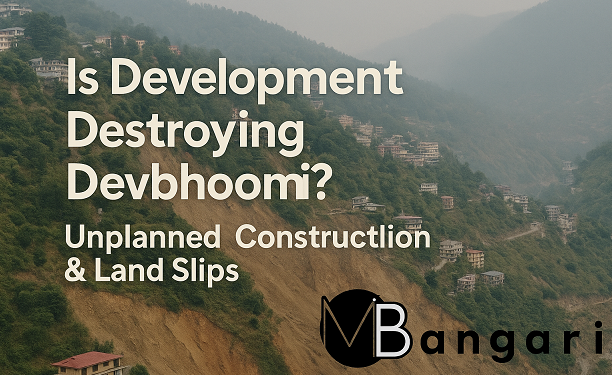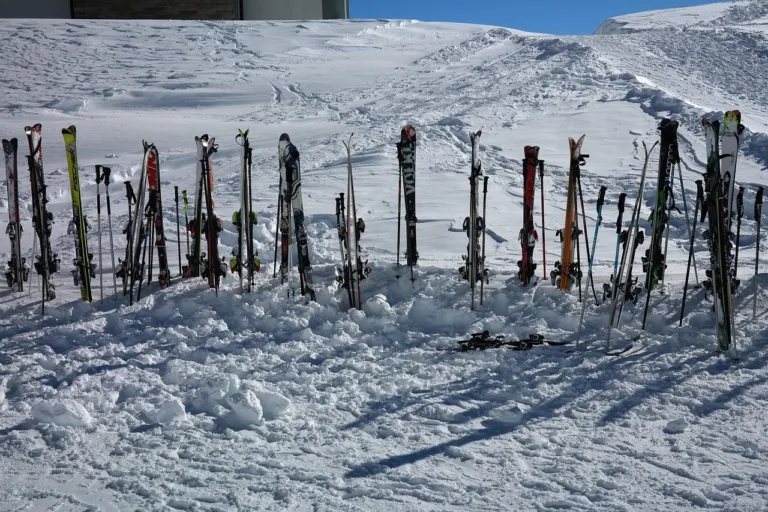By – Mohit Bangari
07 July 2025

Explore Himalaya With Me!!

Himalayas are sacred. We proudly call it Devbhoomi – the land of gods. But today, this divine land is facing a serious threat. The reason? Blind development, unplanned construction, and land slipping at an alarming rate.
In recent years, landslides, floods, road collapses, and sinking towns have become common in Uttarakhand and Himachal Pradesh. But why is it happening? And what can we do about it? Let’s understand everything in detail.
Unplanned development means building roads, hotels, tunnels, or markets without proper study of the mountain’s condition. In many hill towns, builders cut mountains carelessly and block natural water paths. Forests are destroyed. Concrete is poured in every open space. Drainage systems are weak or missing.
Mountains are not like plains. They are fragile. When we disturb their natural structure, they collapse — especially during rains or earthquakes.
There are many causes. Some are natural, but most are man-made.
Mountains are cut using heavy machines for roads and buildings. Many times, slopes are left exposed without retaining walls or step-cutting. During monsoon, water enters the cracks and causes massive slips.
Places like Shimla, Joshimath, Manali, Mussoorie, and Badrinath are overloaded with hotels, guesthouses, shops, and roads. Open ground is vanishing. Natural drainage is blocked. When it rains heavily, water doesn’t get an outlet and starts damaging the base soil.
In villages and old towns, there used to be small water streams (nallahs) for natural flow. Many of these are now cemented or covered, leading to water accumulation under the land.
In Garhwal, Kumaon, and parts of Himachal, soil is soft and glacial. It needs special care. But often, projects are made without geological study or local advice.
A big example is Joshimath, where land sinking became a major issue in 2022–2023. People’s houses developed deep cracks. Roads were broken. The reason? Years of careless construction, tunnel drilling for Tapovan project, and no proper water outlet system. Local people had raised concern earlier, but were ignored.
In fact, on my blog, I have written in detail about such sensitive regions and their challenges. You can also read my article – Why People Are Leaving Their Villages – The Ghost Village Problem of Uttarakhand – where I discussed how development pressure is forcing migration from hill villages.
Both state and central governments have now started taking this matter seriously. Some positive steps include:
Geological mapping by agencies like Wadia Institute and GSI (Geological Survey of India) in landslide-prone areas.
Early warning systems for landslides using satellite and sensors.
Char Dham Road project now being made with revised environmental norms after Supreme Court’s advice.
Rehabilitation projects for affected people in Joshimath, Tehri, and other zones.
Construction bans in red and yellow zones in some districts.
Guidelines issued for eco-sensitive zones near Badrinath, Kedarnath, Gangotri, and Yamunotri.
In Himachal Pradesh too, departments are now identifying landslide-prone towns and doing drainage improvement works.
Though these steps are coming a bit late, still it is a good beginning. But strict action and regular monitoring is very important.
There are many simple and powerful ways to stop such problems. If followed seriously, Devbhoomi can be saved.
Stop construction in fragile zones. No building, hotel or road should be allowed in areas where slope and soil are weak.
Use traditional pahadi architecture. These homes are made with wood, stone, and mud – they balance heat and weight.
Plant more trees. Roots of trees hold the soil together. Forests must be protected.
Strict environmental impact assessment (EIA) before any big project.
Limit number of tourists in eco-sensitive areas during peak season.
Drainage system improvement. Every town must have a working natural and artificial drainage plan.
Encourage rainwater harvesting and slope step-farming.
Listen to local people. They know the land better than anyone else.
Development is important, but it must not destroy the very land we love. The Himalayas are alive. They breathe, they hold stories, and they carry the energy of gods. We must develop with balance and wisdom.
Let’s not wait for more disasters. Let’s become more responsible. Together – with proper planning, scientific methods, and traditional wisdom – we can protect our Devbhoomi.
You can also explore more on Himalayan treks like Darma Valley, Adi Kailash, and others on my website mohitbangari.com, where I share full guides, routes, permit tips and cultural info.
By – Mohit Bangari
07 July 2025
Do you know about Ramman festival of Salud-Dungra village? It’s one of the intangible world cultural heritage of India in UNESCO. You can read a detailed article on this topic here.


Explore Himalaya With Me!!